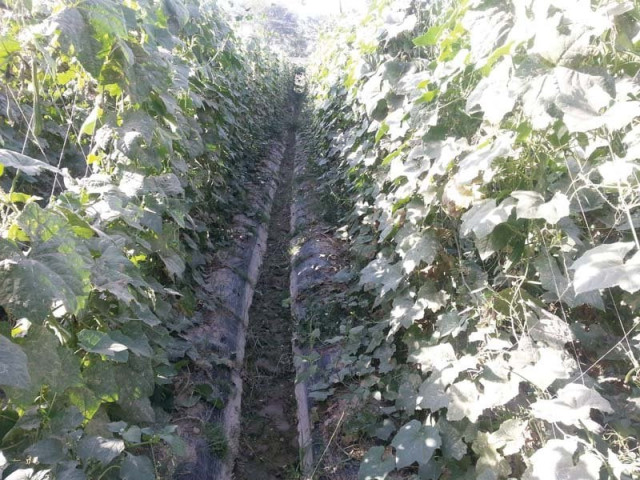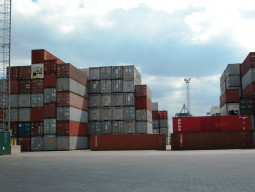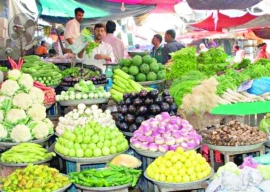
According to estimates of the Punjab agricultural department, there are more than 200,000 acres of tunnel farms in Punjab and the trend is growing. A very high urbanisation rate in Pakistan keeps creating greater demand for vegetables in the urban centres.
The procedure
Currently, most tunnel farms remain between 10 to 20 acres in size and begin cultivation in autumn. That’s when support structures made out of bamboos, steel or aluminum pipes and steel wire ropes are erected around the plantation. These structures form rows that are 4 to 5 feet wide and have a height that’s between 3 to 12 feet. Known as low tunnels, walk through tunnels or high tunnels in their parlance. The higher the structure the more expensive it is to erect. Polythene sheets are spread on top of the structures, creating tunnel like cocoons within which vegetables are grown.
The winter sunshine passes through the transparent polythene sheets and its heat is trapped inside; while in the cold weather, the frost and the winter rains are kept well outside. This makeshift greenhouse deceives the vegetables into believing that it’s time to flower and fruit. As the weather warms up, the polythene sheets are removed.
The vegetables from tunnel farms arrive two to three months earlier than the same varieties grown conventionally in the open. Consumers no longer have to wait till April; they can savor their favourite vegetables in early spring or even in the middle of winters. Off-season arrival ensures that they command higher prices. This remains the single most important economic driver for tunnel farming.
Tunnel farmers routinely achieve an astonishing 500% yield over conventional farmers. Surprisingly, it’s not done by using exotic seeds or fertilisers. Instead, tunnel farmers adopt low-tech methods. All of their inputs such as the bamboo sticks, metal pipes, steel wire ropes, and polythene sheets, fishing lines, seeds, fertilisers and insecticides remain mundanely commonplace. What’s surprising is the innovative use that they put these inputs to; and with stunning results.
Mulching is one such technique in which they cover the ground with black polythene sheets and puncture evenly-spaced holes in it. Vegetable seeds are sown into these holes. This eliminates weeds that consume and ultimately waste the nutrients. Devoid of sunlight, nothing else apart from the plant itself can grow. The sheet also trap moisture in the ground and prevents its rapid evaporation. Conventional farming loses up to 50% of its water to rapid evaporation, tunnel arming doesn’t.
While within each row, thin fishing lines are strung as mesh to provide vertical space for the vegetables to grow. Most vegetables have indeterminate growth, much like creepers and vines. These mesh provide vertical pathways for the plant to grow. Depending on the height of the tunnel, each plant therefore grows at least three to five times larger in size and its reach than its conventionally grown, on ground twin. Consequently, it also bears more fruits.
Tunnel farmers also apply three to five times more chemical fertilisers and micro nutrients than conventional farmers. Every day, they patrol their tunnels much like a spinning mill owner would patrol his spindle frames. The ripe vegetables are identified, picked, weighed and sold daily under their watchful eyes.
Threat to traditional farming?
Their fivefold yields and higher off season sales prices have created a very disruptive technology that has been overtaking conventional farming with breathtaking and ruthless efficiency. A tunnel farmer, possessing no land and armed only with the know-how, can start by leasing an acre for less than $2000, spend $1,000 on erecting tunnel structures, another $3,000 on seeds, fertilisers and insecticides. He can set aside working capital for labour and energy at $2,000. That’s a total investment of $8,000. If his plan goes well, he can generate up to $18,000 from vegetable sales out of his single acre, making a $10,000 tax free windfall.
Within a single season, he not only recovers his initial investment but can easily double his land holding for the next growing season. That’s the well-trodden path most beginners have taken in their rags to riches stories. In the process, they have also inspired countless others to follow their footsteps.
For the smart and the nimble, tunnel farming has opened up new opportunities where the barriers to new entrants remain surprisingly low. Where little investment and a lot of knowledge and innovation together with hard work can create unprecedented upward mobility.
Karachi has the largest demand in the country for vegetables. It also has the highest disposable income in the hands of its consumers. Most of Karachi’s off season vegetable demand is met from tunnel farms of central Punjab.
Karachi’s young and educated entrepreneurs can make use of this opportunity. They can lease cheap and plentiful land from absent land lords in lower Sindh, where prices remain at 1/4th the level of Punjab. By creating tunnel farms, they can replicate the success of their Punjabi counterparts, much closer to home.
The writer is an entrepreneur who has worked in Bangladesh’s garment sector
Published in The Express Tribune, June 8th, 2015.
Like Business on Facebook, follow @TribuneBiz on Twitter to stay informed and join in the conversation.


















COMMENTS
Comments are moderated and generally will be posted if they are on-topic and not abusive.
For more information, please see our Comments FAQ